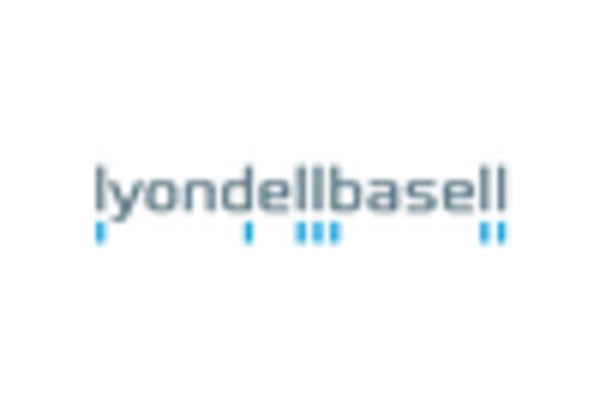Growth in Pharmaceutical Applications
The Butylene Glycol Market is also witnessing growth due to its applications in the pharmaceutical sector. This compound is utilized as a solvent and stabilizer in various drug formulations, enhancing the solubility and bioavailability of active ingredients. The pharmaceutical industry is projected to expand at a rate of around 4.5%, which could lead to increased utilization of butylene glycol in drug manufacturing. Furthermore, the rising prevalence of chronic diseases necessitates the development of effective medications, thereby driving the demand for excipients like butylene glycol. This trend suggests a promising outlook for the Butylene Glycol Market, as pharmaceutical companies continue to innovate and improve their product offerings.
Technological Advancements in Production
The Butylene Glycol Market is poised for growth due to ongoing technological advancements in production processes. Innovations in manufacturing techniques are enhancing the efficiency and sustainability of butylene glycol production. For instance, the adoption of bio-based feedstocks is becoming more prevalent, which aligns with the increasing emphasis on sustainability within the chemical industry. As production costs decrease and environmental impacts are mitigated, manufacturers are likely to increase their output of butylene glycol. This shift suggests a positive outlook for the Butylene Glycol Market, as companies strive to meet both economic and environmental goals.
Increased Use in Food and Beverage Industry
The Butylene Glycol Market is benefiting from its growing applications in the food and beverage sector. As a food additive, butylene glycol is recognized for its role as a flavoring agent and humectant, contributing to the texture and stability of various products. The food and beverage industry is anticipated to grow at a compound annual growth rate of approximately 3.8%, which may enhance the demand for butylene glycol. With consumers increasingly favoring processed foods that maintain quality and freshness, the incorporation of butylene glycol in formulations is likely to rise. This trend indicates a favorable environment for the Butylene Glycol Market, as manufacturers seek to meet consumer expectations for quality and safety.
Expanding Applications in Industrial Sectors
The Butylene Glycol Market is experiencing expansion due to its diverse applications across various industrial sectors. Beyond cosmetics and pharmaceuticals, butylene glycol is utilized in the production of plastics, resins, and coatings. The industrial sector is projected to grow at a rate of approximately 4.0%, which may lead to increased demand for butylene glycol as a versatile chemical intermediate. As industries seek to enhance product performance and durability, the incorporation of butylene glycol into formulations is likely to rise. This trend indicates a robust potential for the Butylene Glycol Market, as it adapts to the evolving needs of multiple sectors.
Rising Demand in Cosmetics and Personal Care
The Butylene Glycol Market is experiencing a notable surge in demand, particularly within the cosmetics and personal care sectors. This compound serves as a humectant, solvent, and skin-conditioning agent, making it a preferred ingredient in various formulations. The market for cosmetics is projected to grow at a compound annual growth rate of approximately 5.3%, which is likely to bolster the demand for butylene glycol. As consumers increasingly seek products that enhance skin hydration and texture, manufacturers are incorporating butylene glycol into their formulations. This trend indicates a robust growth trajectory for the Butylene Glycol Market, driven by the evolving preferences of consumers towards high-quality personal care products.


















Leave a Comment